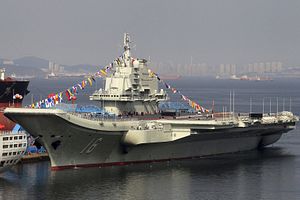After three years of training, Beijing has announced that its aircraft carrier Liaoning and attached air units are ready for operation. Although the People’s Liberation Army (PLA) has formidable air power, the Liaoning would be the only feasible platform for power projection in the foreseeable future, beyond the newly built airstrips in the South China Sea, due to China’s lack of overseas airbases. The Liaoning‘s limited capacity for aircraft could mean regional countries are able to deal with the challenge posed by the carrier.
Since the end of the Cold War, managing fighter capability has been a difficult issue for many Indo-Pacific countries thanks to the high costs of purchasing, upgrading, maintaining, and operating such aircraft. Furthermore, fighters have almost no role to play during peacetime; other than intercepting unidentified aircraft, they are mostly useful for military parades and national ceremonies. Unlike other military capabilities, which can justify their value by participating in peace operations, counterterrorism, humanitarian aid and disaster relief, fighters are generally misfits in the environment of operations other than war.
Prior to China’s aircraft carrier assuming full operations, it seemed unlikely that fighters would be adapted to take part in regional skirmishes. As of now, the regional armed conflicts are usually limited in scale, such as vessel rammings or border fire exchanges. Since there was no clear or present demand for airpower, some countries such as Cambodia and New Zealand gave up their fighter wings, and others such as Malaysia chose to make only token procurements of fighters to retain their symbolic capability.
The newly operational aircraft carrier signifies China’s increased capacity in force projection, but it is not as superior as that of the United States. Each U.S. carrier strike group hosts about 70 combat aircraft supported by aerial warning, refuelling, and electronic warfare capabilities (and remember, the U.S. Navy could bring more than one group to a conflict), China’s capability to host about 36 shipboard fighters on its lone carrier is relatively small. Plus, an aircraft carrier usually has to retain several fighters for self-defense rather than launching an all-out attack, meaning Liaoning would likely not deploy all 36 fighters at once.
In addition, the Liaoning’s ski-jump flight deck would constrain the efficiency of operating fixed winged aircraft, requiring less frequent take-offs, a shorter combat radius, and fewer payloads. The Chinese escort surface combatants may launch land attack cruise missiles to compensate for the decreased payload of shipboard combat aircraft, but small numbers of cruise missiles with small warheads, usually less than half a ton, suggest their limited capacity to supplement aircraft.
Given these constraints, it will be possible for some regional countries to develop their airpower to match the increased capabilities provided by the Chinese aircraft carrier. In the face of a PLA Navy (PLAN) expedition, a regional state’s air force, if composed of a similar or slightly smaller number of 4th or 4.5 generation fighters, equivalent to the Chinese J-15, could have considerable capability to counter. A regional air force can deploy its land-based aircraft to more than one place, perhaps protected by robust shelters and camouflage, so that it may not be possible to annihilate them in one or two waves of attack.
Apart from quantitative steps (i.e. simply purchasing more fighters), other countermeasures present alternatives for regional states to strengthen their airpower in the face of China’s build-up. If the regional air force is equipped with surface-to-air missiles (SAMs), aerial warning and command systems (AWACS), or other air defense capabilities, the PLAN fighters would find it much more difficult to establish air superiority. Without securing air superiority, J-15 fighters would be occupied with aerial combat patrols or suppressing air defenses, and thus their scope for strategic missions, such as bombing political centers, would be restricted.
Moreover, as long as the regional state’s combat aircraft are still potentially available, due to its vulnerability to minor attacks, such as attacks targeting the flight deck, the Chinese aircraft carrier would keep a safe distance. Additional distance will decrease the J-15s’ efficiency on all missions, with the fighters operating with less hang time and a shorter strike radius, while the regional state gains more time to prepare for incoming airstrikes. Provided that the regional country owns certain sea denial capabilities, such as long-range anti-ship missiles or submarines, the situation could be even unfavorable for the PLAN aircraft carrier group to conduct its strategic missions.
The main challenge would come if Beijing adds more aircraft carriers, which means more J-15 fighters, to the PLAN, but such an acquisition process is usually more expensive and time-consuming than purchasing land-based fighters. And unless Beijing overcomes the shipboard aircraft ejector conundrum, future carriers will also be saddled with the low efficiency and capacity of a ski-jump flight deck, meaning that quantitative and qualitative restrictions continue.
In other words, many regional countries in Southeast and South Asia, at least those beyond the combat radius of Chinese land-based aircraft, can avoid becoming trapped in a position of inferior airpower, despite the PLAN’s additional aircraft carrier group(s). In fact, Beijing is facing multifront geostrategic circumstances, which may not allow it to concentrate all its aircraft carrier groups in a single area of operation. This geopolitical reality will further boost the odds of regional countries’ balancing China’s expeditionary airpower. Despite its overall massive military capability, Beijing’s aircraft carrier(s) may not serve well in “gunboat diplomacy,” since the airpower of its carriers is not overwhelmingly superior.
Two squadrons of fighters could be a reasonable goal for regional countries to upgrade their air defenses at an acceptable cost. Defense planners in respective states could further adjust the content of their air forces with the other elements, such as SAMs, mentioned above to optimize the relations between combat efficiency and costs. By taking such steps, regional countries could independently preserve their security, rather than relying on a less certain third party.
Wu Shang-su is Research Fellow at the S. Rajaratnam School of International Studies (RSIS), Nanyang Technological University, Singapore.

































